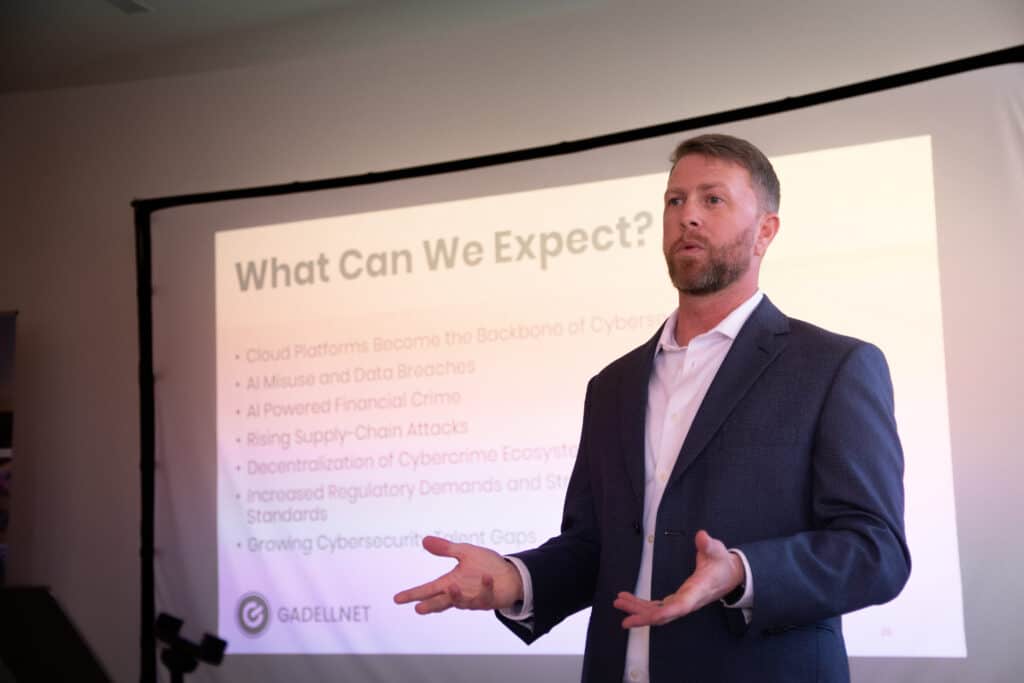Cybersecurity is more than simply a technical issue—it’s a business imperative. With the continued rise in remote work, cloud computing, and AI-powered applications, the potential for cyber threats has expanded significantly. These realizations drive the mandate for innovation in cyber defense, they represent an increase in the risk of attack, and demand investments in cyber protection for your business.
It’s a lot. It’s overwhelming and it poses a significant challenge for business leaders. How do we prepare, what can we expect, where should we invest? To name a few.
We’re here to help shed some light on the cybersecurity trends you need to watch out for.
The Threat Landscape in 2025
Cybercrime continues to intensify. It’s projected to cost the global economy over $10.5 trillion annually by the end of this year. The scale and complexity of threats have changed, as cybercriminals now use more advanced techniques, including AI-powered tools to both automate attacks and create more convincing communications.
According to Check Point’s 2025 Cyber Security Report, there was a 58% rise in infostealer attacks in 2024 alone. Infostealer is malware designed to steal login credentials, financial information, and other sensitive data. These attacks often act as the entry point for larger breaches, such as ransomware attacks and system-wide compromises.

AI & the Arms Race in Cybersecurity
Artificial intelligence has become a double-edged sword of cybersecurity trends. On the one hand, it enhances defense capabilities by analyzing patterns in network traffic, identifying anomalies, and enabling real-time responses to threats. AI-driven threat detection is now crucial for identifying attacks before they spread. On the other hand, bad actors are using AI to scale up phishing campaigns, create deepfake content, and uncover system vulnerabilities faster than ever before.
Ransomware, APTs, & Supply Chain Risks
Ransomware continues to be a top concern, but tactics are evolving. Instead of simply encrypting data, attackers now frequently exfiltrate it and threaten to release sensitive information unless a ransom is paid. Groups like RansomHub and BianLian have pioneered this approach, bypassing the need for encryption and focusing solely on data theft. There’s also been a cybersecurity trend in the decentralization of some of these cybercrime groups, resulting in a rapidly expanding landscape of new cyber threats.
Meanwhile, advanced persistent threats (APTs), often backed by nation-states or organized crime, are continuing to ramp up their efforts. APTs often see bad actors living inside of your systems for weeks to months completely undetected. This degree of unregulated access to data is a goldmine for threat actors whose primary objective is to steal data, and/or infiltrate the supply chain to broaden their attack surface.
These threats don’t only extend to your own systems, but also to those in your supply chain. Bad actors can infiltrate these partner organizations and use their contacts to appear more reliable. Imagine receiving an invoice from one of your points of contact’s email address, not knowing their account has been compromised and you’re speaking with a cybercriminal. This happens. A lot.
Creating A Culture of Security
Technology alone can’t stop every threat. In fact, human error remains one of the leading causes of security breaches. That’s why companies are increasingly prioritizing a culture of security. This means regular, engaging cybersecurity training for employees, simulated phishing exercises, and clear communication about how to handle suspicious activity.
When employees understand their role in safeguarding data, organizations become significantly more resilient. Encouraging a security-first mindset at every level—from interns to executives—makes a measurable difference. It’s often stated that humans are the weakest link in your organization’s defense; I would counter that with proper training and executive support, they can also be your greatest defense.
Building a Modern Defense Strategy
So, what now? How do we prepare and what do we do if (when) we’re the victim? The answer lies in a layered defense strategy. AI-driven threat detection tools help catch malicious behavior early. Zero-trust architectures—where no user or device is automatically trusted—ensure tighter access controls. Cloud-native security platforms improve visibility across hybrid environments, while endpoint detection and response (EDR) systems protect the growing number of devices accessing corporate networks.
Incident response planning is also key. The faster a threat is identified and contained, the less damage it can cause. The Check Point report found that organizations that responded within 24 hours of detecting a breach reduced overall impact by over 60%.
Looking Ahead
The cybersecurity trend landscape in 2025 is complex, but not insurmountable. With the right tools, processes, and mindset, organizations can stay ahead of the curve. AI will continue to play a central role, both as a tool and a threat. Ransomware will evolve, social engineering will persist, and supply chain vulnerabilities will remain a concern. But the organizations that invest in proactive strategies—and prioritize cybersecurity from the top down—will be best positioned to thrive.
Don’t go in alone. If you’ve got the team and the talent to dedicate to cyber protection, you’re off to a great start. If you don’t, there’s help. Businesses, like ours, are built around the idea that businesses, like yours, could use one or two less things to worry about. Cybersecurity is a primary focus of what we do here. If you’re overwhelmed, not sure how to move forward, concerned that you’re at risk – let us help you.
